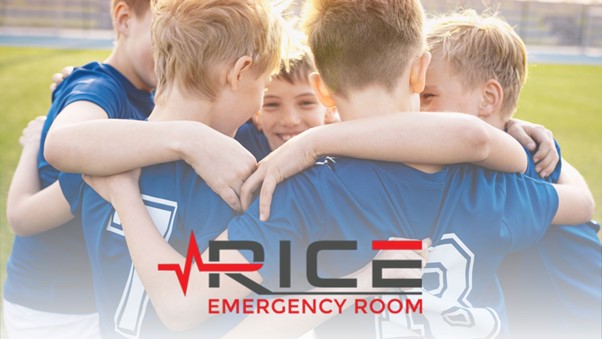Navigating Pediatric Sports Injuries
Fall Sports Season and the Role of Rice Emergency Room
Navigating pediatric sports injuries remains a constant for families as they usher in the excitement surrounding the kick-off of various sports seasons in the fall. Young athletes in Houston and West U. are gearing up to embrace football season, cheer, soccer and volleyball. However, with the thrill of competition comes an inevitable increase in sports-related injuries, sending many young athletes and their parents rushing to the ER.
When Pediatric Sports Injuries Surge
Fall sports seasons are synonymous with high-intensity training and competition. While these activities promote physical fitness, teamwork, and discipline, they also bring an increased risk of sports-related injuries. According to the American Academy of Pediatrics (AAP), the fall season often sees a surge in pediatric sports injuries, ranging from sprains and fractures to concussions. These injuries can have long-lasting effects on a child’s physical and emotional well-being if not addressed promptly and properly.
Common Pediatric Sports Injuries
- Sprains and Strains: Sprains (injuries to ligaments) and strains (injuries to muscles or tendons) are some of the most prevalent sports-related injuries. These injuries can occur in various sports and result from sudden movements, overuse, or improper technique. Commonly affected areas include ankles, knees, and shoulders.
- Fractures: Fractures, or broken bones, are another common occurrence in youth sports. They can range from hairline fractures to more severe breaks, often affecting the arms, wrists, legs, and fingers. Contact sports like football and soccer pose a higher risk of fractures.
- Concussions: Head injuries, particularly concussions, are a grave concern in youth sports. The American Orthopaedic Society for Sports Medicine (AOSSM) emphasizes the importance of proper helmet use and strict adherence to concussion protocols. Concussions can lead to long-term cognitive and emotional challenges if not managed appropriately.
- Overuse Injuries: Many young athletes engage in year-round sports and intensive training, which can result in overuse injuries such as stress fractures, tendonitis, and growth plate injuries. These injuries often require specialized care and rehabilitation.
Rice Emergency Room: Here When You Need Us Most
Rice Emergency Room is staffed with Board Certified ER Physicians. Our state-of-the-art medical facility offers 24/7 access to X-ray and CT diagnostics, enabling swift and accurate assessments of sports-related injuries.
Here’s why Rice Emergency Room stands out:
Rapid Diagnosis: In the event of a sports injury, time is of the essence. We’ll see you in less than 10 minutes. Rice Emergency Room’s state-of-the-art X-ray and CT diagnostics allow for quick and precise diagnoses, ensuring that young athletes receive timely medical attention.
Experienced Medical Team: Rice Emergency Room boasts a team of experienced medical professionals who specialize in emergency medicine. They are well-equipped to provide immediate treatment and create a synchronized hand-off back to your personal physician for extended care and follow-up.
Professional Insights on Pediatric Sports Injuries
American Academy of Pediatrics (AAP): In a recent statement, the AAP recommended delaying tackle football until age 12 to reduce the risk of head injuries among young players. This underscores the importance of age-appropriate sports participation and injury prevention strategies.
National Institutes of Health (NIH): A study published by the NIH highlights the need for injury prevention programs and safety measures in youth sports. It emphasizes that proper coaching, athlete education, and protective equipment are crucial for reducing the incidence of sports-related injuries.
American Orthopaedic Society for Sports Medicine (AOSSM): AOSSM stresses the importance of promoting a culture of safety in youth sports. They advocate for regular medical check-ups, preseason physicals, and education on injury prevention techniques to safeguard young athletes.
We’re With You for the Duration
As fall sports seasons kick off with enthusiasm and fervor, it’s essential to acknowledge the inherent risks of pediatric sports injuries. Sprains, fractures, concussions, and overuse injuries are a stark reality for young athletes, but with the right care and prevention strategies, we can minimize these risks. Rice Emergency Room, with our 24/7 X-ray and CT diagnostics, plays a pivotal role in ensuring that injured athletes receive prompt and accurate medical attention. By implementing the insights and recommendations of the experts, we can work together to make youth sports safer and more enjoyable our community.
Works Cited:
“Delaying tackle football until age 12 to reduce the risk of head injuries.” AAP, www.aap.org/en-us/about-the-aap/aap-press-room/pages/aap-recommends-no-tackle-football-before-age-12.aspx
Birosz, Márton Tamás, et al. “Layer Adhesion Test of Additively Manufactured Pins: A Shear Test.” Polymers, U.S. National Library of Medicine, 24 Dec. 2021, www.ncbi.nlm.nih.gov/pmc/articles/PMC8747663/ .
“Youth Sports Injury Prevention.” AOSSM, www.sportsmed.org/aossmimis/




